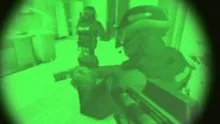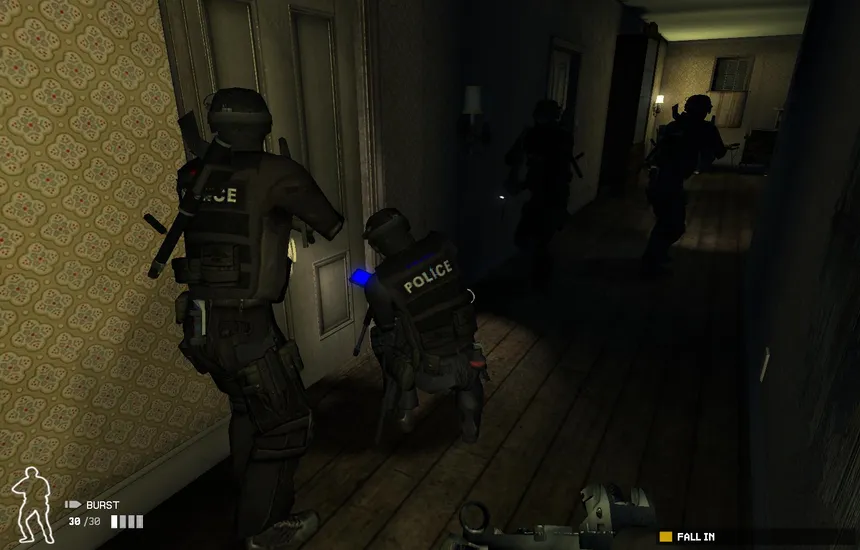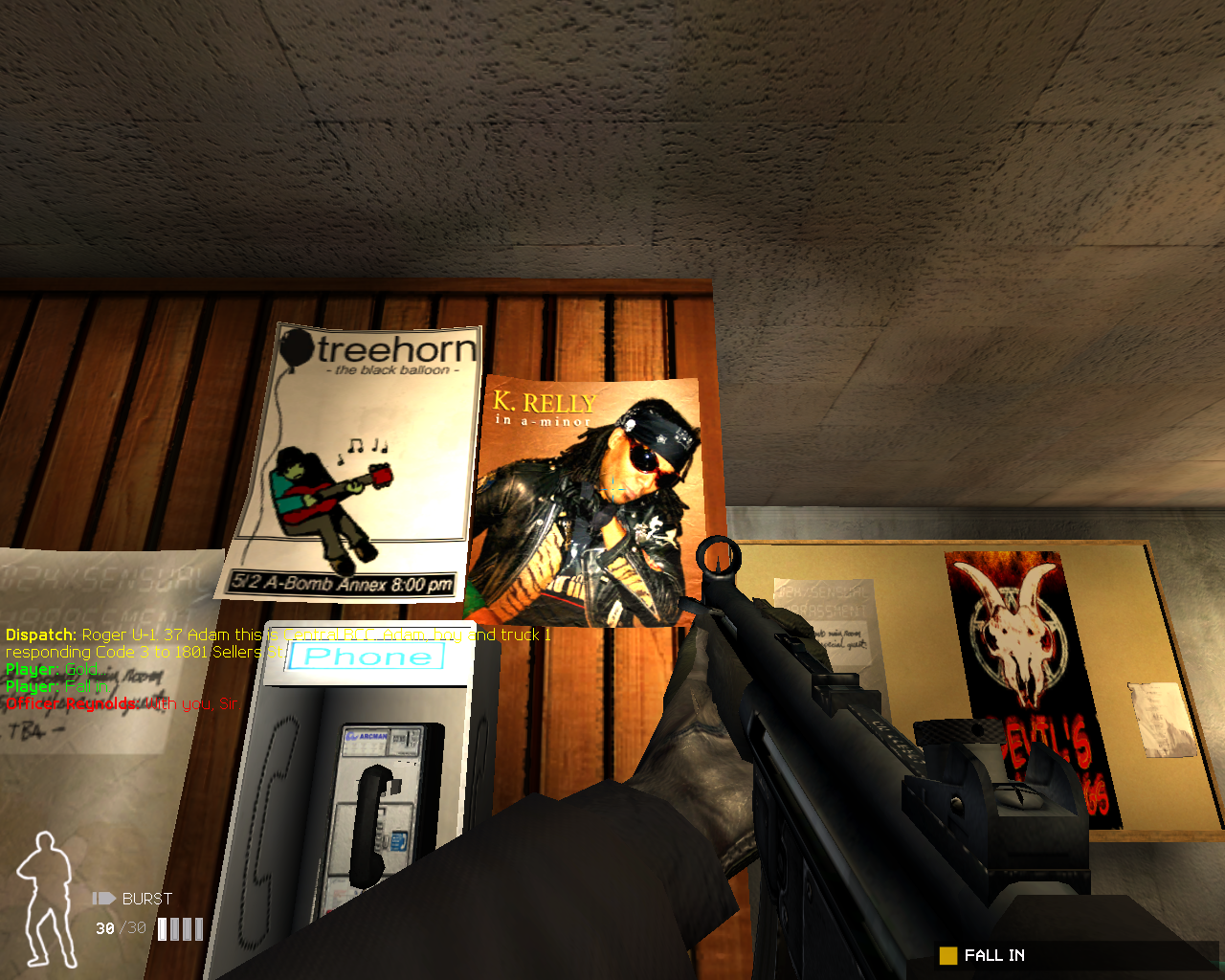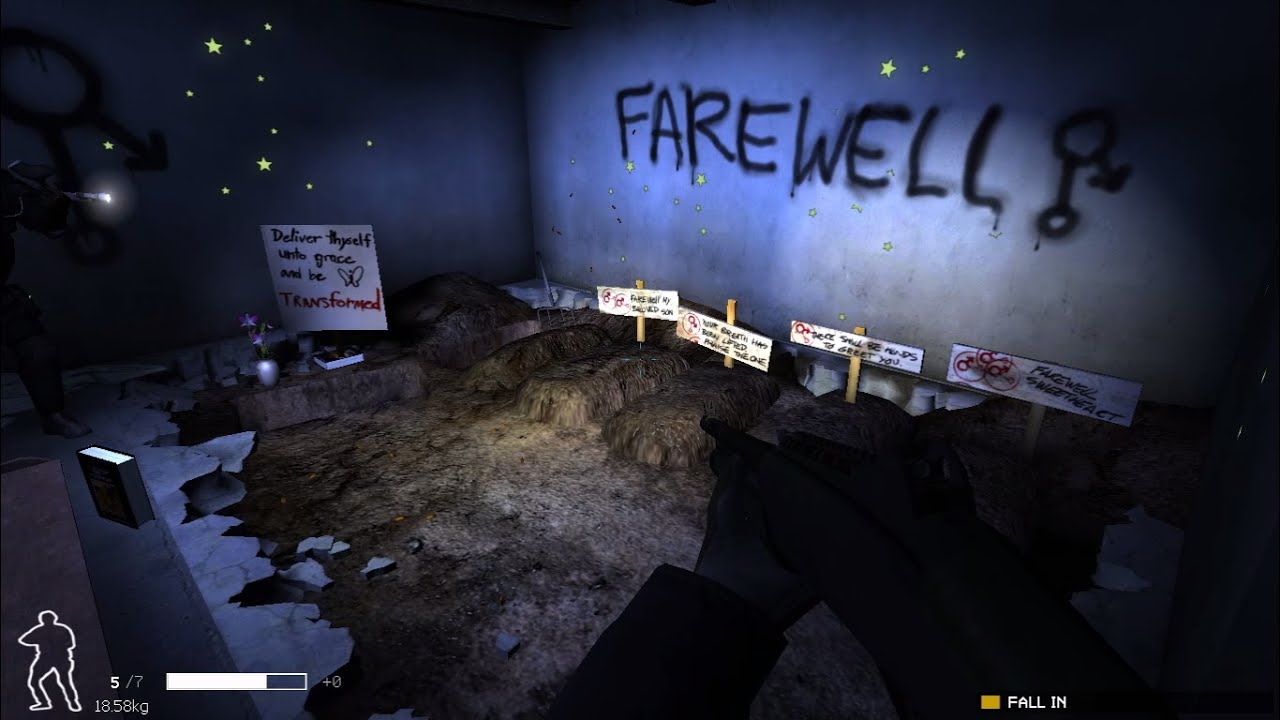SWAT 4: a game of reflex.
Introduction
Building on the foundations laid by SWAT 3, which was the first 3D FPS in the Police Quest series, SWAT 4 was released in 2005 and was met with favourable reviews albeit unremarkable sales. SWAT 4 wasn't the only tactical shooter on the block, Rainbow Six 3 and Hidden & Dangerous 2 were only 2 years old by the time SWAT 4 released, so it wouldn't be unfair to assume that many thought SWAT would be another Rainbow Six clone. But that is far from the truth, and it was one of the most unique and intense shooters ever released.
About SWAT 4
It's not just about the badge, it's about the rush.
SWAT 4 places you in the boots of a SWAT team leader, where you are deployed on a wide range of callouts. From simple high risk warrants to active hostage situations, danger and uncertainity wait around every corner. Self disicpline and rationality are vital to succesfully completing a mission. SWAT is for preserving lives, not ending them, and disregarding the rules of engagement carries consequences. Analyse the situation, ask questions before shooting, know your surroundings, and do all of that in a split second.
Gameplay
The gameplay in SWAT is simple on paper; take out the bad guys, rescue the civilians. But that's just the tip of the iceberg, for SWAT 4 does something most shooters don't: Rules of Engagement (RoE). Like real life, law enforcement must follow basic RoE, which to summarise, tries to preserve life. In gameplay terms, this means you cannot shoot a suspect unless they are an immediate threat to the lives of others, or have already shot at people. This aspect of the game is what makes it so notoriously intense. Clearing rooms suddenly becomes alot harder when you can't behave like a South American deathsquad - having to make sure no civilians are caught in the crossfire, making sure complying suspects don't pick up their weapons again, all the while keeping you and your squads life intact.
SWAT 4 offers you a lot of non lethal compliance tools, like pepper spray, tasers and beanbag shotguns, all of which have their perks and downsides. For example, a beanbag shotgun is a powerful compliance tool, but shoot someone too many times and they may get incacpitated or even die. You must play slowly and methodically in order to avoid unneccassary casualities, and in the chaos of a firefight, you must still keep composed and make every shot count. One misfire can kill a civilian or your squadmate, and the whole mission is jeopardized. Breaking the RoE too many times, regardless if all objectives are complete, can still fail a mission.

The vast majority of your time in this game will be spent creeping around the map and making preparations to breach rooms, encountering suspects and civilians on the way. The actual breaches themselves can last only seconds, and ALOT can happen in those few seconds. How you breach makes a huge difference and it is of utmost importance to take notes of other exit and entry points, as well as blindspots. A breach can go wrong in so many ways. Sometimes, the perps are expecting you and will open fire the second you open the door - other times, civilians may get restless and run around, causing confusion and can lead to accidental deaths. Some perps wear gas masks, which makes breaching with CS futile. There are so many variables in breaching it would take too long to list. All of these dangers combined with the smart and deadly AI makes the game a truely exilirating experience, giving the player a genuine rush and sense of achievement after a successful breach.
SWAT is a punishing game. There is no health regeneration or healing at all, the AI can be incredibly deadly and unpredictable and there are no savestates. One mistake could lead to a mission fail, potentially undoing 30 minutes of work. No savescumming out of this one. Getting shot in the leg slows you down to snailpace for the rest of the mission, and getting shot in the arms or chest widens your crosshair, making your shots less accurate. Getting shot in the head is usually instant death, both to you and perps. All of these challenges make it that much more exciting when you are about to breach that final room.
Squad
Your squad is your most powerful weapon in SWAT 4, and it is important to keep them alive - watch their back, and they will really watch yours. Your squad is made up of you and 4 other officers, seperated into 3 teams (red team 2 officers, blue team 2 officers, gold team all officers. Anything you can do, you can order your squad to do, which truely gives you free reign over a mission. Like the perps, squad AI is equally deadly and they can complete breaches without any player presence at all, though it's always best to go in with them as no AI is perfect. They will check corners, aim up when walking up stairs and usually know when to use lethal or non lethal force. Each squad member has a unique, fully customisable loadout and can be assigned a multitude of pre-made loadouts already present in the game, if you can't be bothered to manually tweak every loadout. What weapons you give to your team make a massive difference and every variable must be checked out if you want to win. It's a good idea to check a missions floorplans before beginning, as it gives you a general idea of how close or far engagement distance will be. Naturally for smaller tighter maps like someones home, it's a good idea to equip the squad with SMGs and shotguns. On maps with more open spaces like dancefloors, assault rifles and SMGs would be more useful.
Preparing to breach.

Equipment
High risk situations call for high tech equipment, and SWAT 4 gives the player the most state of the art equipment of 2005. From special forces classics like the MP5, to the 'new' optiwand, every piece of equipment has a useful role to play. The optiwand is by far the most important tool in the game, as it allows you to peak around corners and doors. Despite that, it's not a get-out-of-danger-free card, as its view can easily be obstructed by things in the room, which a perp could, and generally does, hide behind. Another essential piece of equipment is door wedges. These are used to jam doors from both sides, preventing anyone from entering or exiting. This is incredibly useful in corridoors with lots of intertwining doors, as it can prevent perps from encircling you. It is also useful for containing perps to one room, so that you may come back to them later without worrying about them roaming around.
There are also the more typical SWAT gear; flashbangs, CS gas and sting grenades, all of which do what they say on the tin. There are two types of breaching equipment, C2 charges and breaching shotguns. C2 will blow a door open, harming and somtimes killing anyone who is right on the otherside, which makes it dangerous when hostages are near by. But they are also great for lowering a perps morale, as the loud bang makes them more likely to surrender. Breaching shotgun lets you blow the door open too, but without explosives, which makes it safer, though it does take longer. When seconds mean everything, sometimes the breaching shotgun is too slow and you must take the risk with C2.
Of course, you can always take the more stealthy approach and lockpick the door. Sometimes it's actually better to do this, especially if the perp is facing away from the door. If you sneak in, you can surprise the perp and order him to surrender, all without firing a shot or using a C2 charge. This method is still dangerous though, as there could be multiple out of sight perps waiting to ambush you.
As mentioned earlier, the game offers some non lethal weapons too. Pepper spray, beanbag shotguns, pepperball gun and tasers. It's generally a good idea to have at least one person in the squad carry a piece of non lethal equipment. The taser being my personal favourtite as it still allows for a lethal primary weapon. When facing terrorists and religious fanatics, non-lethal equipment is incredibly challenging to use and in my opinion not worth it as it needlessly gets squad members killed. On the higher difficulties, you will need to make use of non-lethal weapons alot more, as the score required to pass the mission increases with each difficulty level. Unauthorized lethal force will deduct points from your final score and can lead to a mission fail.
Lethal weapons are your classic SWAT team guns - M4, MP5, Glock 17, M1911, M90 Super and a couple others. They are all quite powerful and other than the Glock, rarely take more than 4 shots to kill someone. Of course, this depends on what kind of ammo you use. FMJ is better against armoured targets, hollowpoints against unarmoured. The main difference between the guns are their recoil and fire rate. You can empty an m4 in about 2 or 3 seconds when firing full auto, and the recoil will make you miss every shot. It's best to use semi auto on all guns, or burst fire on guns that allow it. The UMP fires a .45 round, which gives it more stopping power than the MP5, however the MP5 can fire in bursts or semi auto, whereas the UMP can only fire in semi auto or full auto. Little differences like these must be taken into consideration when gearing up for a mission, as it all makes a difference.
Immersion and Maps
SWAT 4 places you in many different environments, each with their own tactical challenges. From simple residencies to complex research centres, every map has its own distinct feel. When including the Stetchkov Syndicate DLC, the game has 20 maps, each taking about 30 mins to clear when not taking mission restarts into account. Each of these maps are incredibly atmospheric thanks to the games phenomenal soundtrack, combined with the slow and methodical pacing. The immersion in SWAT 4 is second to none and is frankly the most immersive tactical shooter I have ever played. There is no hand-holding at all; you spawn in the map and the game leaves you to approach the situation any way you want, which is sorely needed in games today. For example, remember the hype around the 'Clean House' mission in CoD Modern Warfare? Fans and critics alike praised it for its gritty realism and immersion, however, there was very little freedom in the mission. You had to follow the path the devs wanted you to take, you couldn't shoot anyone the devs didnt want you to shoot. All of the mission was scripted and whilst it looked cool, thats all it was - an interactive movie.
In SWAT 4, all of that, and more, can happen in-game and you get to experience and control all of it. No mission plays the same, as perps and civilians are placed in random areas every time, making no mission predictable. You have to actually listen out for footsteps and watch for shadows as just one stray gunman can wipe out your squad if the odds are in his favour. Perps also don't telegraph their attacks as obviously as they do in most games. You have to actually watch them as opposed to games like Assasins Creed, where they magically glow up signalling for you to block their attacks. There is no cutscenes at all and very few scripted events, and even those don't affect gameplay, they are just unique dialogue lines from your squadmates. Even your squadmates are unique and memorable, each with their own cool voices and almost-cliche badass cop personalities. When you breach a room and your whole squad is shouting and barking orders, it really adds to the believability of a volatile situation.
You also must report everything to your commanding officer, as each report is counted towards your final score for the mission. You must report downed officers, dead suspects, incapicitated suspects, dead civlians, incap civilians, arrested suspects and restrained civilians. Again, this just adds more to the immersion and is yet another aspect that seperates it from being another terrorist hunt-esque tactical shooter. SWAT 4 is even funny at times, and is very reminicent of GTA style puns and wordplay, and some visual gags like when you beat the training mission, your squad are only too pleased when they are rewarded with a box of donuts.

The maps themselves are hard to describe with mere words. The two community favourites, Fairfax Residence and Children of Tarronne Tenement, are well known in tactical shooter circles for good reasons - they feel real. The Fairfax Residence mission tasks you with arresting a suspected serial killer operating in the area, and the mission its self isn't hard. It's the environmental story telling that makes it so beloved. The house is in poor condition and there is evidence of foulplay all over, and you can even find the killers mother, who refuses to believe her son is a beast. Going lower into the house is like going deeper into the killers mind - you will find masks, tools and other suspicious items until eventually finding a makeshift tunnel. Going into that will lead to a room, where you will find a tied up, husk of a woman pleading for her life. Sometimes, the killer will be in there with her but as mentioned earlier, placement of perps is different each time you play.
The other map, Children of Taronne Tenement, tasks you with dismantling a cult based in a decrepit apartment block. You must arrest or kill the leader and rescue all civilians. What makes this map so memorable is the utter insanity of the cult. Walls are covered in graffitti and followers regurgitate the words of their leader. Some are grateful for you sieging the complex, others are not so grateful and will try to kill you, with surrender being the last thought on their mind. Civilians and cultists all look the same too, making target confirmation even harder than usual. The most shocking part is when you find the mass grave of a bunch of kids, presumably human sacrifices. When first seeing this, I was genuienely stunned that a game would include content like this. SWAT 4 isn't afraid to show the ugly realities of our world but at the same time it isn't preachy about it like Ready or Not. Frankly you'd have to play for yourself to truely appreciate what I'm trying to say, because words simply can't describe the atmosphere of this game.

Modding Scene
If 20 maps isn't enough for you, there are hundreds if not thousands of community made maps available. All SWAT 3 maps are available for download, and there is even some conversion mods, which I have not used personally, but they are supposed to be great QoL improvements and AI improvements. Graphical overhaul mods and new textures for both perps and your squad are available too. The modding community for SWAT 4 is surprisingly active considering the game is nearly 20 years old.
Flaws
SWAT 4 has some very annoying issues at times, the main one for me being that my squadmates ignore orders a lot. It's not constantly, but it happens enough times to be mentioned. It can really mess up a breach when for example, you have blue team on one door and red on another, and red simply doesn't breach because they just ignore the order. Without covering both entrances, you or your squadmates will die or at least get injured, so it can't be understated how frustrating this bug can be. Another issue is practically a meme in the SWAT community - your squadmates constantly complaining that you're in their way. Every time you lockpick or deploy C2 charges, or just stand still, one or more of your squadmates will say "you're in my way sir" and they will keep repeating that until you move. That gets incredibly annoying during a several hour session though there is a mod that disables it.
Sometimes, your squadmates have no sense of personal safety and will attempt to use non lethal tools against perps who will clearly not surrender. More often than not, they will die and because your squadmate is standing right next to the perp, its impossible to kill the perp without killing your squadmate, which leaves you in a very tight spot. Generally squad AI is really good which means you tend to notice alot more when they're not good. During the mission in the hospital, there was one perp left and I spent ages searching the hospital. I ordered my squad to open and clear a room and they didn't see any perps and just stood there. Only as I was leaving did I notice a perp just crouching practically in the middle of the room, barely covered by a table. Had I not killed him on the spot, (unorthodox, I know) the whole mission could've failed.
Finally, the RoE can be very punishing at times. It is a great system but there are some times where points are deducted for completely unfair reasons. Of course, a standoff is frantic and sudden movements will get perps killed much like real life, but the game sometimes doesn't acknowledge this. Sometimes you cant tell if a perp is fake-surrendering or running towards or away from you. A fleeing perp sometimes runs towards you and even if they're armed, shooting them will deduct points which is stupid because it's impossible to tell if they're going to shoot or not. At the same time though, that is what makes SWAT 4 so enjoyable, having to make these kinds of judgements and convince yourself it was the right thing to do.
Conclusion
Style and substance, SWAT 4 has both. Infinite replayability, cheap as chips and a brutal challenge to scratch the itch of the most hardened tactical shooter fan. Buying this game is a no brainer for any real tactical shooter fan. Despite the issues mentioned above, there is still no other tactical shooter that comes this close to being perfect. Every move you make (pun intended) matters and being such a slow game at times can be a turn off for players unaccustomed to tactical shooters. Why buy this when Ready or Not exists? Well Ready or Not is a whole other can of worms which will be opened on another day, but to summarise, why pay £50 for an unfinished game from shady developers when you can play the gold standard, which also runs on practically any computer, for £8? Just remember SWAT 4 is a 20 year old game and in some cases, it shows, but as the ancient Chinese proverb goes: "If it aint broke, don't make a crappy cash-grab clone 20 years later."








